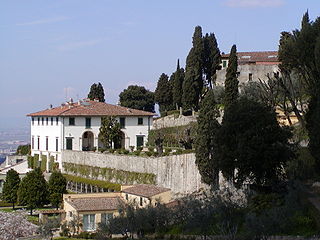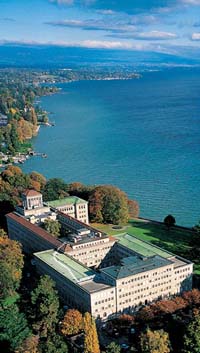Related Research Articles

Geneva is the second-most populous city in Switzerland and the most populous city of Romandy, the French-speaking part of Switzerland. Situated in the south west of the country, where the Rhône exits Lake Geneva, it is the capital of the Republic and Canton of Geneva.

Lake Como, also known as Lario, is a lake of glacial origin in Lombardy, Italy. It has an area of 146 square kilometres (56 sq mi), making it the third-largest lake in Italy, after Lake Garda and Lake Maggiore. At over 400 metres (1,300 ft) deep, it is the fifth deepest lake in Europe, and the deepest outside Norway; the bottom of the lake is more than 200 metres (660 ft) below sea level.

A villa is a type of house that was originally an ancient Roman upper class country house. Since its origins in the Roman villa, the idea and function of a villa have evolved considerably. After the fall of the Roman Republic, villas became small farming compounds, which were increasingly fortified in Late Antiquity, sometimes transferred to the Church for reuse as a monastery. Then they gradually re-evolved through the Middle Ages into elegant upper-class country homes. In the Early Modern period, any comfortable detached house with a garden near a city or town was likely to be described as a villa; most survivals have now been engulfed by suburbia. In modern parlance, "villa" can refer to various types and sizes of residences, ranging from the suburban semi-detached double villa to, in some countries, especially around the Mediterranean, residences of above average size in the countryside.
The Latsis Foundation is a charitable foundation, founded in 1975 by the Greek shipping magnate John Latsis.

Castle Hill is a 56,881 sq ft (5,284.4 m2) Tudor Revival mansion in Ipswich, Massachusetts built 1926-1928 as a summer home for Mr. and Mrs. Richard Teller Crane, Jr. It is also the name of the 165-acre (67 ha) drumlin surrounded by sea and salt marsh the home was built atop. Both are part of the 2,100-acre (850 ha) Crane Estate located on Argilla Road. The estate includes a historic mansion, 21 outbuildings, and landscapes overlooking Ipswich Bay, on the seacoast off Route 1, north of Boston. Its name derives from a promontory in Ipswich, Suffolk, England, from which many early Massachusetts Bay Colony settlers immigrated.

Hortus conclusus is a Latin term, meaning literally "enclosed garden". At their root, both of the words in hortus conclusus refer linguistically to enclosure. It describes a genre of garden that was enclosed as a practical concern, a major theme in the history of gardening.

The Nemours Estate is a 200-acre (81 ha) country estate with jardin à la française formal gardens and a French neoclassical mansion in Wilmington, Delaware. Built to resemble a French château, its 105 rooms on four floors occupy nearly 47,000 sq ft (4,400 m2). It shares the grounds at 1600 Rockland Road with the Nemours Children's Hospital, Delaware, and both are owned by the Nemours Foundation.

The French landscape garden is a style of garden inspired by idealized romantic landscapes and the paintings of Hubert Robert, Claude Lorrain and Nicolas Poussin, European ideas about Chinese gardens, and the philosophy of Jean-Jacques Rousseau. The style originated in England as the English landscape garden in the early 18th century, and spread to France where, in the second half of the 18th century and early 19th century, it gradually replaced the rigidly clipped and geometrical French formal garden.

The Centre William Rappard at Rue de Lausanne 154, Geneva, Switzerland, was built between 1923 and 1926 to house the International Labour Office (ILO). It was the first building in Geneva designed to house an international organization. In 1975 the ILO moved to Grand Saconnex and in 1977 the Centre William Rappard was occupied by the secretariat of the General Agreement on Tariffs and Trade (GATT), the UN High Commissioner for Refugees, and the library of the Graduate Institute of International and Development Studies. By 1995, the World Trade Organization (WTO) replaced the GATT and became the main occupant of the Centre William Rappard. In 2008–2013, the building was completely renovated and an extension was constructed to make available more office space and meeting rooms.

Denis Duboule is a Swiss-French biologist. He earned his PhD in Biology in 1984 and is currently Professor of Developmental Genetics and Genomics at the École polytechnique fédérale de Lausanne (EPFL) and at the Department of Genetics and Evolution of the University of Geneva. Since 2001, he is the Director of the Swiss National Research Center "Frontiers in Genetics" and since 2017, he is also a professor at the Collège de France. He has notably worked on Hox genes, a group of genes involved in the formation of the body plan and of the limbs.

The Bibliothèque de Genève, founded in 1559, was known as Bibliothèque publique et universitaire from 1907 to 2006.
Ulrich K. Laemmli is a Professor in the biochemistry and molecular biology departments at University of Geneva. He is known for the refinement of SDS-PAGE, a widely used method for separating proteins based on their electrophoretic mobility. His paper describing the method is among the most cited scholarly journal articles of all time. His current research involves studying the structural organization of nuclei and chromatin within the cell.
The culture of Rome in Italy refers to the arts, high culture, language, religion, politics, libraries, cuisine, architecture and fashion in Rome, Italy. Rome was supposedly founded in 753 BC and ever since has been the capital of the Roman Empire, one of the main centres of Christianity, the home of the Roman Catholic Church and the seat of the Italian Republic. Due to its historical and social importance, Rome has been nicknamed the Caput Mundi, or "capital of the world".

The Louis Vuitton Foundation, previously Louis Vuitton Foundation for Creation, is a French art museum and cultural center sponsored by the group LVMH and its subsidiaries. It is run as a legally separate, nonprofit entity as part of LVMH's promotion of art and culture. The art museum opened on October 20, 2014, in the presence of President François Hollande. The Deconstructivist building was designed by American architect Frank Gehry, with groundwork starting in 2006. It is adjacent to the Jardin d'Acclimatation in the Bois de Boulogne of the 16th arrondissement of Paris, bordering on Neuilly-sur-Seine. More than 1.4 million people visited the Louis Vuitton Foundation in 2017.
The Geneva University Hospitals is one of the five university hospitals of Switzerland and the largest one in the country. It is one of the largest hospitals in Europe.

The Musée d'histoire des sciences de la Ville de Genève is a small museum in Switzerland dedicated to the history of science.

Villa Scotti-Cornaglia-Noseda-Bertani, commonly known as Villa Fiorita, is a building in Lombardy, Italy, where the Brugherio Comune's headquarters are housed.

The Palm Trees Park, also known simply as Las Palmeras, is a public park in the heart of Pontevedra in Spain. It is the most representative and emblematic green space in the city centre, together with the Alameda de Pontevedra.
References
- ↑ "Fondation Louis-Jeantet de Médicine". The Europa International Foundation Directory 2020. Routledge. 16 August 2020. ISBN 9781000287684.
- ↑ "Presentation of the Center". Fondation Louis-Jeantet. (Geneva's Florissant area contains the Natural History Museum of Geneva and the Centre médical Universitaire of the Geneva University Hospitals.)
- ↑ Weilacher, Udo (24 May 2005). "Garden for the Fondation Jeanette de Médicine in Geneva: A sunken hurtus conclusus". In Gardens: Profiles of Contemporary European Landscape Architecture. Walter de Gruyter. pp. 142–146. ISBN 9783764376628. p. 143, p. 145, p. 146
- ↑ "From cedar to cedar - Ville de Genéve" (PDF). geneve.ch.